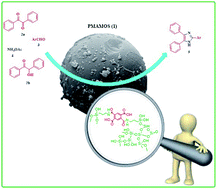Pyromellitic diamide–diacid bridged mesoporous organosilica nanospheres with controllable morphologies: a novel PMO for the facile and expeditious synthesis of imidazole derivatives†
Abstract
In this work, novel pyromellitic diamide–diacid bridged mesoporous organosilica (PMAMOS) nanospheres with controllable morphologies and Brønsted acid catalytic centers were designed and prepared through a convenient method by altering the addition sequence of precursors, solvent, and aging time. The obtained PMAMOSs demonstrate high surface areas and uniform pore sizes. FESEM, HRTEM, BET, EDX, XRD, FTIR and TGA analyses were performed to characterize and examine the effective factors for the preparation of PMAMOS nanospheres. Due to the appropriate physicochemical properties including Brønsted acid centers, suitable surface area and thermal stability of the PMAMOS nanosphere material, it was explored in the three-component reaction of benzyl or benzoin, ammonium acetate, and different aldehyde derivatives as a case study of multicomponent reactions. Corresponding imidazole derivatives were obtained in EtOH under reflux conditions in high to quantitative yields and short reaction times. It was also shown that the heterogeneous solid acid can be reused at least five times with negligible loss of its catalytic activity, indicating the appropriate stability and high activity of the newly introduced mesoporous organosilica.

- This article is part of the themed collection: Popular Advances


 Please wait while we load your content...
Please wait while we load your content...